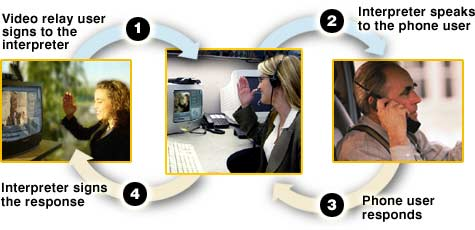Introduction: How Video Relay Service Works
The Federal Communications Commission (FCC) regulates a number of disability-related telecommunications services, including video relay service (VRS). VRS is a form of telecommunications relay service (TRS).1 The service allows persons with hearing disabilities, using American Sign Language (ASL), to communicate with voice telephone users through video equipment rather than through typed text. Video equipment links the VRS user with a "communications assistant" (CA) so that the VRS user and the CA can see and communicate with each other in signed conversation (see Figure 1).
 |
|
Source: Gallaudet University, "Accessible Emergency Notification and Communication: State of the Science Conference (Presentation)," http://tap.gallaudet.edu/Emergency/Nov05Conference/Presentations/maddix_files/textmostly/slide2.html. |
VRS has quickly become a very popular service. It offers several features not available with the text-based TRS:
- People with hearing disabilities can communicate using ASL rather than typing what they want to say. This allows them to incorporate facial expressions and body language into their conversations, which cannot be done using text.
- A VRS call is more like a telephone conversation between two hearing persons. For example, the parties can interrupt each other. The parties cannot interrupt each other during a traditional TRS call because the parties have to take turns communicating with the CA.
- Conversation flows more naturally between the parties, so the conversation may take place more quickly than with TRS.
- VRS calls may be made between ASL users and hearing persons speaking either English or Spanish.
VRS is different from other forms of TRS in two important ways: (1) the conversation between the VRS user and the CA is made through a video link and sign language rather than typed text; and (2) the service relies on the Internet, rather than the public telephone system, for the connection between the VRS user and the CA. Also, unlike some other forms of TRS, VRS is not mandatory.
Program Overview
VRS is free to the caller, and VRS providers are reimbursed for their costs from the TRS Fund.
Management
Since July 1, 2011, the TRS Fund has been administered by Rolka Loube Saltzer Associates, LLC (RLSA). Prior to that date, the fund was administered by the National Exchange Carriers Association.
VRS Provider Service Standards
VRS providers are subject to certain requirements and prohibitions:
- Eighty percent of all VRS calls must be answered within 120 seconds.
- Service must be offered 24 hours a day, seven days a week.
- VRS providers must provide their users with a 10-digit telephone number, so users will be able to make 911 calls and have their location data routed to the appropriate emergency agency.
- Preferential treatment of calls is prohibited. VRS (and TRS) providers must handle calls in the order in which they are received. They cannot selectively answer calls from certain consumers or certain locations.
- Equipment distributed by a certified VRS provider must be interoperable with the technology of other certified VRS providers.
- VRS (and TRS) providers may not offer financial incentives to use their service or to make more or longer VRS (or TRS) calls.
Funding Source
The VRS program is funded through the larger TRS Fund. The TRS Fund2 is a revolving fund financed through contributions by all providers of interstate telecommunications services.3 Contributions are based on a "contribution factor" that is set on an annual basis by the FCC.
Provider Contributions, Compensation, and Reimbursement
On June 20, 2017, the FCC extended existing (i.e., 2016-2017) VRS rates on a provisional basis. For VRS providers with more than 500,000 monthly minutes, the per-minute VRS compensation rates are:
- $4.06 for minutes that fall within Tier I (a provider's first 500,000 monthly minutes);
- $4.06 for minutes that fall within Tier II (a provider's second 500,000 monthly
minutes); and - $3.49 for minutes that fall within Tier III (a provider's monthly minutes in excess of 1,000,000).
For VRS providers with 500,000 or fewer monthly minutes, the per-minute VRS compensation rate is $4.82. Based on these compensation rates, the maximum rates within the range of VRS rates proposed by the Commission, projected demand for the services, and projected Fund administration expenses, the FCC adopted a funding requirement of $1,328,188,285, and a carrier contribution factor of 0.02289.4
Policy Considerations
The FCC has implemented changes to the VRS program to reduce fraud and abuse, better manage the amount of money that is collected to fund the program, and take advantage of technological advancements.
The primary concern of the deaf and hard-of-hearing community appears to be that cuts to the fund may result in fewer and less-qualified ASL interpreters, which would decrease the functional equivalency of the service. Additionally, it is concerned that changes in technology—even "better" technology—will decrease competition among service providers, possibly decreasing innovation. Moreover, the community believes that changes in the technology could pose challenges to some users and make placing and receiving calls more difficult.
Congressional Considerations
The deaf and hard-of-hearing community will likely continue to contact Congress whenever changes are proposed for the VRS program. The community relies heavily on the program, so it is understandable that they might view any proposed changes with concern. However, the FCC also has a responsibility to make sure that the fund remains solvent and to take advantage of advances in technology that it has determined will improve the system. Congress may wish to monitor the current proposed changes to the system to ensure that the FCC, while working to modernize TRS technology and minimize financial abuse, also gives full consideration to the concerns of the deaf and hard-of-hearing community.